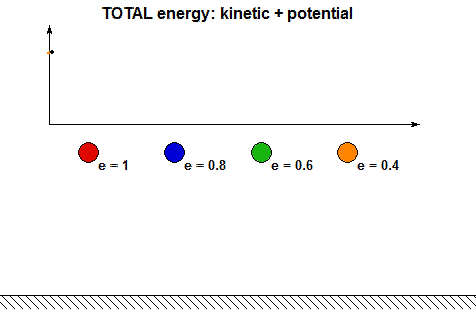Is energy conserved during impacts?
We know that rebound velocities following an impact depend on the coefficient of restitution for the impact. Suppose a particle is dropped on a fixed floor, where e is the coefficient of restitution for the impact. If the particle strikes the floor with a speed v1, we know that the rebound speed is v2 = ev1. The produces a percentage energy change of 100(0.5mv22 - 0.5mv12)/0.5mv12 = -100(1 - e2).
The answer? If e = 1, then energy is conserved. Otherwise, energy is not conserved during impact.
We see these results below for four drop tests with four different values of coefficient of restitution e.

Where does the energy go during an impact?
Background
In our study of impacts in this course, we typically treat the impacting bodies as being rigid (no deformations during impact). This assumption actually masks the reality of the dynamics during impacts: bodies can experience significant deformations during impact, and these deformations can lead to energy being transferred to modes that are not recovered after impact. We account for this energy loss in our analysis by introducing the “coefficient of restitution” for the impact.
Experimental observations
Consider the video below of a golf ball impacting a rigid plate at high velocity. From this video we see very large deformations of the ball, during which energy is lost due to heat and non-elastic deformations. In addition, the ball shows flexible vibrations within the ball, something not accounted for in our rigid body analysis.

Simulation observations
Shown below are animations of simulations performed to model the dynamics of a racquetball impacting a rigid floor. The results from three models are shown, with the flexibility of the ball model increasing from left to right. The racquetball animations show how vibrations are imparted to the ball that accounts for an energy loss in terms of the gross motion of the ball after impact. For these results, the more flexible model experiences larger amplitude vibrations, and as a result, reaching a lower rebound height since more of the rebound energy goes into the vibrations.

